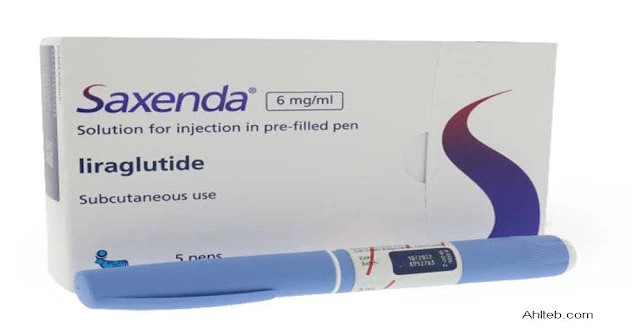Saxenda is an injectable medication prescribed for weight loss and it is beneficial to overweight adults and children (12 to 17 years old) who also have weight-related medical problems.
Saxenda should be used together with exercise and a controlled diet.
The active ingredient in Saxenda is "liraglutide", which is similar to a hormone that occurs naturally in the body and is effective in controlling blood sugar, insulin levels, and digestion.
Effects of Saxenda
Being similar to GLP-1 hormone, Saxenda has the following effects:
- It reaches the appetite center in the brain and causes appetite inhibition so you eat less and lose weight.
- Increases insulin hormone secretion and blood level, which keeps blood sugar in normal ranges or even lower than normal.
- Delays stomach emptying, this leads to a decrease in post-prandial blood glucose.
- Helps patients to exert better in exercise.
- Saxenda gives the best results when combined with exercise and diet.
Saxenda is prescribed for overweight adults with body mass index (BMI) more than 30, or BMI higher than 27 if they suffer Diabetes mellitus, Heart disease, hypertension or Obstructive sleep apnea syndrome.
Side Effects
- Allergy or hypersensitivity
- Nausea and vomiting
- Tachycardia (Increased heart rate), thus contraindicated in cardiac patients
- Feeling tired
- Insomnia or sleep disturbances
- Changes in taste
- Reflux esophagitis
- Mouth dryness
- Stomach pain
- Eructation and flatulence
- Dyspepsia and gastric discomfort
- Pain in the urinary bladder and painful urination
- Cloudy urine and sometimes bloody urine
- Chills
- Cough
- Diarrhea
- Headache
- Hoarseness of voice
- Joint pain
- Loss of appetite
- Pain in the muscles and low back pain
- Over sweating
- Runny nose
- Blurred vision
- Dizziness and nervousness
Rare side effects include:
- Anxiety
- Confusion
- Cold sweat
- Increased hunger
- Bouts of depression
- Itching or skin rash or skin redness
- Nightmares
You should call your doctor at once if you have:
- Very fast or pounding heartbeats;
- severe non-stop vomiting, diarrhea or nausea;
- thoughts of suicide;
- any sudden mood or behavior change;
- Pain in the upper part of the abdomen;
- clay-colored stool;
- skin or eyes yellowing;
- severe pain in the upper stomach (Pancreatitis pain) which may spread to the back and is accompanied by nausea with or without vomiting;
- a lump in the neck, hoarseness of voice, difficulty breathing or swallowing (signs of thyroid tumor);
- Signs of severely low blood glucose level, such as confusion, extreme weakness, over sweating, difficult speaking, breathing rapidly, fainting and convulsions;
- Decreased urination, ankle of feet swelling, difficult urination (signs of kidney disease).
Dose for weight loss
The usual line is "Dose escalation", which helps avoid gastrointestinal symptoms.
You should follow the instructions of your doctor.
For adults, the usual dose is:
- First week: Inject 0.6 mg subcutaneously once a day
- 2nd week: Inject 1.2 mg subcutaneously once a day
- 3rd week: Inject 1.8 mg subcutaneously once a day
- 4th week: Inject 2.4 mg subcutaneously once a day
- 5th week: Inject 3 mg subcutaneously once a day
Maintenance dose is 3 mg per day, injected subcutaneously, but if it is not tolerated, you should discontinue it.
For children, the same dose pattern is followed, but only for children older than 12 years.

